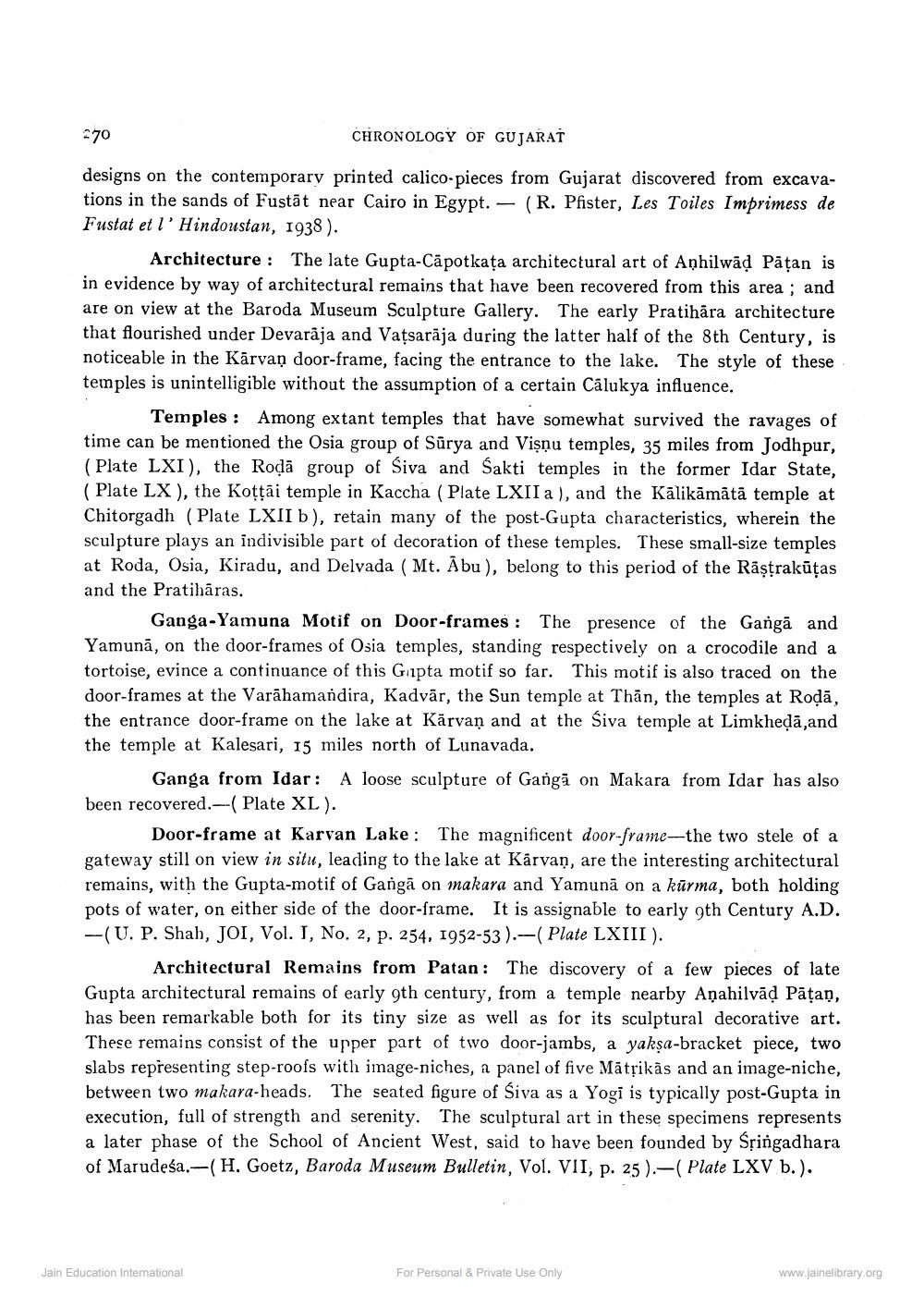________________
270
CHRONOLOGY OF GUJARAT
designs on the contemporary printed calico-pieces from Gujarat discovered from excavations in the sands of Fustāt near Cairo in Egypt. - (R. Pfister, Les Toiles Imprimess de Fustat et l'Hindoustan, 1938).
Architecture : The late Gupta-Cā potkața architectural art of Anhilwād Pāțan is in evidence by way of architectural remains that have been recovered from this area ; and are on view at the Baroda Museum Sculpture Gallery. The early Pratihāra architecture that flourished under Devarāja and Vațsarāja during the latter half of the 8th Century, is noticeable in the Kārvan door-frame, facing the entrance to the lake. The style of these temples is unintelligible without the assumption of a certain Calukya influence.
Temples: Among extant temples that have somewhat survived the ravages of time can be mentioned the Osia group of Sūrya and Vişņu temples, 35 miles from Jodhpur, (Plate LXI), the Roda group of Siva and Sakti temples in the former Idar State, (Plate LX), the Kotţāi temple in Kaccha (Plate LXII a ), and the Kālikāmātā temple at Chitorgadh (Plate LXII b), retain many of the post-Gupta characteristics, wherein the sculpture plays an indivisible part of decoration of these temples. These small-size temples at Roda, Osia, Kiradu, and Delvada (Mt. Ābu), belong to this period of the Râştrakūtas and the Pratihāras.
Ganga-Yamuna Motif on Door-frames : The presence of the Gangā and Yamunā, on the door-frames of Osia temples, standing respectively on a crocodile and a tortoise, evince a continuance of this Gripta motif so far. This motif is also traced on the door-frames at the Varāhamandira, Kadvār, the Sun temple at Thăn, the temples at Rodā, the entrance door-frame on the lake at Kārvaņ and at the Siva temple at Limkheďā,and the temple at Kalesari, 15 miles north of Lunavada.
Ganga from Idar: A loose sculpture of Gangā on Makara from Idar has also been recovered.-( Plate XL).
Door-frame at Karvan Lake: The magnificent door-frame-the two stele of a gateway still on view in situ, leading to the lake at Kārvan, are the interesting architectural remains, with the Gupta-motif of Gangā on makara and Yamunā on a kūrma, both holding pots of water, on either side of the door-frame. It is assignable to early 9th Century A.D. -(U. P. Shah, JOI, Vol. I, No. 2, p. 254, 1952-53).---( Plate LXIII).
Architectural Remains from Patan: The discovery of a few pieces of late Gupta architectural remains of early 9th century, from a temple nearby Aņahilvāļ Pāțaộ, has been remarkable both for its tiny size as well as for its sculptural decorative art. These remains consist of the upper part of two door-jambs, a yakşa-bracket piece, two slabs representing step-roofs with image-niches, a panel of five Mātřikās and an image-niche, between two makara-heads. The seated figure of Siva as a Yogi is typically post-Gupta in execution, full of strength and serenity. The sculptural art in these specimens represents a later phase of the School of Ancient West, said to have been founded by Sringadhara of Marudesa.-(H. Goetz, Baroda Museum Bulletin, Vol. VII, P. 25).- Plate LXV b.).
Jain Education Intemational
For Personal & Private Use Only
www.jainelibrary.org




